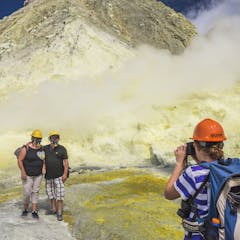
Artículos sobre Volcanoes
Mostrando 1 - 20 de 217 artículos

Millions of years ago, widespread volcano eruptions in eastern Australia buried entire forests. Today, these time capsules reveal stunningly fossilised plants.

To fight global warming we will soon have to try to remove carbon dioxide from the skies or find ways to reflect the Sun’s heat. Such radical paths must be examined, but risky experiments avoided.

Iceland, Hawaii and Italy have all tried to control lava to save cities in the past. A volcanologist explains the methods.

Iceland is known as ‘the land of fire and ice’ for a reason.

Releasing reflective particles into the upper atmosphere would help us tackle climate change – but it’s not without risk.

Iceland’s volcanic activity is generally tame compared with explosive eruptions along the Pacific’s Ring of Fire. This time, it’s shaking up a town.

Evidence suggests magma is close to the surface in south-west Iceland, prompting evacuations.

Everyone involved in the tourism industry will need to manage risk differently after a court found the landowners of Whakaari/White Island guilty of breaching the Health and Safety at Work Act.

Pandemic restrictions prevented Jónsi (frontman of Sigur Rós) from experiencing firsthand the eruption of Fagradalsfjall, Iceland. He made this work in response.

Like icy thermometers, glaciers overlying volcanoes shift according to temperature changes below.

More than 90% of the world’s pink diamonds came from a single mine that closed in 2020. Geologists are only now beginning to understand the forces that create the rare, highly prized gems.

Many ‘myths’ are authentic memories of human pasts, told by people who passed down precise accounts of their history.

Climate change is causing increasingly severe weather – but it’s not just hazards at the Earth’s surface we should be concerned about.

The bad news: Extreme heat is probably going to stick around for a couple of more years.

Scientists were not previously certain how the precious stones arrived at the Earth’s surface.

For some people, it’s a choice based on cultural beliefs or economic opportunities provided by the volcano. Other times it’s less a choice than the only option.

One in ten people around the world live near an active volcano. Understanding the drivers of eruptions is crucial.

The eruption was so large, it created its own space weather and satellite technology disruptions – here’s how.

Some rocks will burn, and others will melt, depending on how they were formed and what minerals they contain.

The volcanic eruptions that bring diamonds to Earth’s surface are driven by ‘pillars of heat’ stretching deep inside the planet.

